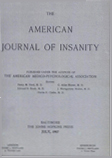PSYCHOSES IN THE COLORED RACE
Abstract
1. As to the facts brought out, the tables show the conclusion is warranted that in the colored race a large increase of mental disorder is obvious since their attainment of freedom, and that, too, in localities favorable to the race.
2. That the mental mechanism in the given psychoses does not essentially differ in the two races.
3. That the dementia precox type is the preponderant mental disease entity among the colored, but it is not excessively disproportionate to the same manifestations in the whites; that there is an excess of the hebephrenic type in both races; that the number of catatonics in the colored exceeds the number in the whites, and that there are more of the paranoid type in the whites than in the colored.
4. That manic-depressive psychosis is not as prevalent among the colored as in the whites, and that in the colored the excited phase of this psychosis is more frequently observed, while the depressive types are not so common.
5. That involutional melancholia and depressions of various forms are rare in the colored, as these individuals do not react to the graver emotions—grief, remorse, etc.—owing to the fact that they have no strict moral standard and no scrupulosity as to social conventions; the absence of self-depreciatory ideas of sin, etc., is most noticeable.
6. That the prevalence of syphilis in the colored race has had a marked influence on certain types of mental disorder, as general paresis, cerebral syphilis and other luetic infections, and that these are very much in excess of the same diseases in the whites.
7. That while the colored race indulge in and imbibe large quantities of alcohol, they are in a degree immune to its influence and the reaction to its toxic effects is less lasting.
8. That paranoid conditions are present, but that true paranoia is rare, especially among the colored women.
9. That hysteria is a disease which is rare in the colored.
Access content
To read the fulltext, please use one of the options below to sign in or purchase access.- Personal login
- Institutional Login
- Sign in via OpenAthens
- Register for access
-
Please login/register if you wish to pair your device and check access availability.
Not a subscriber?
PsychiatryOnline subscription options offer access to the DSM-5 library, books, journals, CME, and patient resources. This all-in-one virtual library provides psychiatrists and mental health professionals with key resources for diagnosis, treatment, research, and professional development.
Need more help? PsychiatryOnline Customer Service may be reached by emailing [email protected] or by calling 800-368-5777 (in the U.S.) or 703-907-7322 (outside the U.S.).



